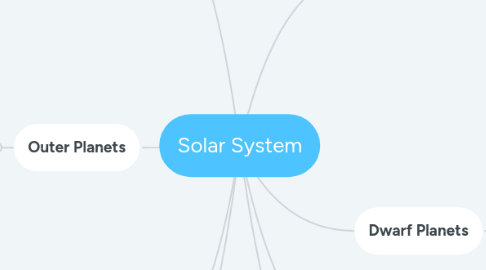
1. The Sun
1.1. Core
1.2. Radiative Zone
1.3. Convective Zone
1.4. Photosphere
1.5. Chromosphere
1.6. Corona
2. Outer Planets
2.1. Jupiter
2.1.1. Largest Planet
2.1.2. Strong magnetic field
2.1.3. Many moons
2.2. Saturn
2.2.1. Extensive ring system
2.2.2. Made mostly of hydrogen and helium
2.2.3. Has the moon Titan, which is larger than Mercury
2.3. Uranus
2.3.1. Coldest Atmospheric Temperatures
2.3.2. Tilted on its side
2.3.3. Methane gives it a blue hue
2.4. Neptune
2.4.1. Most distant planet from the Sun
2.4.2. Strongest winds in the solar system
3. Asteroid Belt
3.1. Between Mars and Jupiter
3.2. Contains millions of asteroids
4. Comets
4.1. Made of ice, rock, and dust
4.2. Have tails that point away from the Sun
5. Inner Planets
5.1. Mercury
5.1.1. Closest to the sun
5.1.2. No atmosphere
5.1.3. Temperatures vary greatly due to no atmosphere
5.2. Venus
5.2.1. Thick cloud cover
5.2.2. Contains 96% carbon dioxide
5.2.3. Hottest planet in the solar system
5.3. Earth
5.3.1. Only known planet with life
5.3.2. Made up of 70% water
5.3.3. One gravitational pull
5.4. Mars
5.4.1. Iron rich surface gives it's red color
5.4.2. Ice at the poles and beneath the surface
5.4.3. Thin, mostly carbon dioxide atmosphere
6. Dwarf Planets
6.1. Pluto
6.1.1. Reclassified from Planet to Dwarf Planet
6.1.2. Has five known moons
6.2. Eris
6.2.1. Most massive dwarf planet
6.2.2. Discovered in 2005
